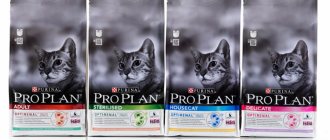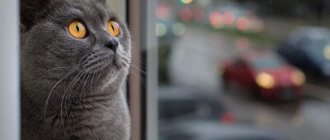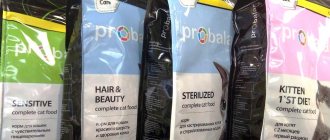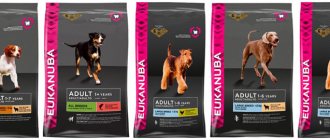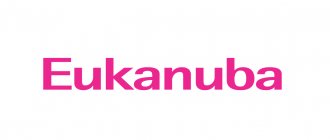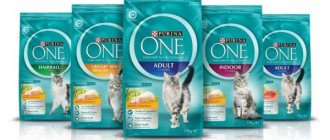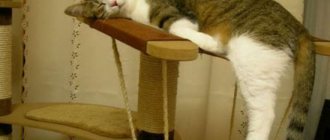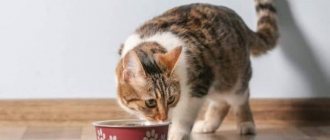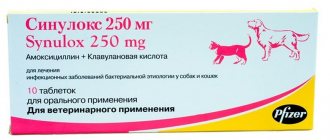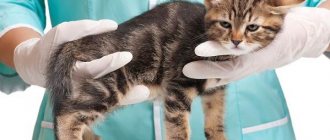Corn has never been a traditional Russian agricultural crop and appeared in large quantities on the fields of the USSR in the 1950s with the light hand of N.S. Khrushchev and was appreciated, perhaps, only in animal husbandry. Let us remind young readers that in those days they did not sell popcorn in cinemas, and in general it was not accepted to eat during the show.
But let’s return to pets and the times when ready-made food for them appeared in Russia. Corn was used in literally every diet sold at that time; there was little information about its nutritional qualities. As a result, perhaps out of ignorance, or perhaps due to someone’s benefit or even dishonesty, false information began to spread among pet owners that this cereal is a source of many beneficial substances for dogs and cats. Moreover, over 20 years this information has become firmly embedded in the consciousness of consumers, and, what is most offensive, continues to thrive in it to this day.
The proof is a message from a reader of our site, who introduced himself as an experienced breeder, in defense of corn, who cites the following quote to prove his position: “Corn has high nutritional properties. It is a good source of Omega-6 fatty acids, which promote the development of healthy skin and a shiny coat, minerals, vitamins including folic acid, vitamin C, niacin and starch. It is noteworthy that here, for cats and dogs, starch is an important source of energy."
The original source of this quote is unknown, but it is widely circulated on the Internet, and we would like to detail the information contained in it, point by point.
Corn in feed - the whole truth about “high nutritional properties”
The highly nutritional properties of corn are determined by the high content of carbohydrates - more than half of them (60 g per 100 g). This is great news for people who want to get better, but not for cats and dogs. People, indeed, get energy primarily from carbohydrates and fats, and to a much lesser extent from proteins. You’ve probably heard about the famous “Kremlin diet”, which consists exclusively of animal proteins and, according to reviews, gives amazing results - note, for the figure, but not for health. It’s in these numbers that her secret lies.
Dogs and cats are structured completely differently: they get most of their energy from fat, and much less from proteins and carbohydrates. Since corn primarily consists of carbohydrates, it, like all other grains, cannot be called highly nutritious for carnivores. Therefore, corn in feed, especially in large quantities, is not only not nutritious, but also extremely unphysiological, and also absolutely useless.
However, perhaps the idea of the high nutritional value of corn in the above quote is associated not with carbohydrates, but with vegetable protein, which is also contained in this cereal (10.3 g per 100 g). However, this idea does not stand up to criticism, since plant protein is very poorly absorbed by carnivores.
Here are the data on the digestibility of protein from various foods in dogs, calculated using the generally accepted hundred-point system. The highest score - 100 - is assigned to the product that has the highest digestibility.
| Protein | Digestibility |
| Egg white | 100 |
| Muscle meat (chicken, beef, lamb) | 92 |
| Internal organs (liver, kidneys, heart) | 90 |
| Milk, cheese | 89 |
| Fish | 75 |
| Soybeans | 75 |
| Rice | 72 |
| Oats | 66 |
| Yeast | 63 |
| Wheat | 60 |
| Corn | 54 |
These indicators show that the protein in corn, and this applies to almost all plant proteins, is digested almost twice as poorly as muscle meat. This means that corn in food for cats and dogs not only does not increase, but complicates the digestibility of the diet.
Corn in Dog Food: Is Starch Healthy?
Surprisingly, corn starch, listed among the vitamins and minerals in the above quote, is actually one of the most harmful components of corn. It is responsible for increasing the risk of diabetes, as well as increasing obesity in dogs and cats. The main reason is the high glycemic index. This indicator gives an idea of how sharply the blood glucose level increases after consuming the product. Foods with a high glycemic index cause a sharp jump in glucose levels, and accordingly, the production of the hormone insulin. The wider the amplitude and speed of this “glycemic swing”, the higher the risk of obesity and diabetes. By the way, this also applies to people. Look at the table and you will see that our corn starch is a real record holder in terms of glycemic index.
| Product | Glycemic index |
| Corn starch | 85 |
| Rice starch | 85 |
| Wheat flour | 85 |
| Potato | 45 |
| Buckwheat | 40 |
| Oats | 40 |
| Beans | 40 |
| Chickpeas | 30 |
| Beans | 30 |
| Peas | 35 |
| Lentils | 27 |
From this table we see that not only corn, but also rice and wheat have a high glycemic index, but legumes, on the contrary, have a low one. That is why many manufacturers refuse to use these grains in their feeds, and since it is impossible to do without carbohydrates in the production of extruded feeds, they replace them with other components with a lower glycemic index.
But this does not mean that legumes are an excellent component in food; they are also not physiological for carnivores, but they are simply the lesser of two evils. But the most important question is the quantity: if corn in cat and dog food was used only as a binding component (and for this you need very little), there would be fewer objections. But when it takes up almost half of the composition and at the same time we are convinced that this is an excellent and COMPLETE ingredient for predators, then this causes nothing but indignation.
List of harmful or restricted products
No matter what anyone tells you, any fish, in any form, is harmful to a cat. Don't give pork. “Human” food from the table, which you yourself eat with pleasure, can be harmful, or even poisonous and dangerous for a cat. This is fried, salted, spiced food, any canned food for people, low-quality cat food (even from advertised manufacturers). Liver and legumes (peas, beans) are not recommended; corn should not be given. Pork and lamb are harmful to cats.
So, why should you limit or even not feed your cat foods from the list above?
- Fish
This product consists mainly of protein. Moreover, it is made from easily digestible protein. What's wrong with that? - you ask. The fact is that when digesting fish, the cat’s body is “overloaded” with protein. Its breakdown products - urea and uric acid - are very harmful to cat kidneys. Improper functioning of the kidneys leads to disruption of the metabolism of mineral salts, and, ultimately, to a serious, often fatal disease - urolithiasis in cats. At the same time, stones may appear in the kidneys or bladder of your pet.
Moreover, it does not matter at all whether the female cat is neutered: if the cat is not fed properly, the disease affects cats of both sexes.
Fish contains too much of some enzymes and other substances that are harmful to cats. This leads to the fact that some amino acids and vitamins, which must be produced in a certain amount in the cat’s body for normal functioning, begin to be produced in insufficient quantities. The result is illness. In particular, the increased content of histamine in fish causes or sharply intensifies allergies in every third cat. And the high content of trimethylamine oxide in many types of fish leads to the development of severe anemia in cats, since this substance binds iron. The enzyme thiaminase leads to the development of vitamin B1 hypovitaminosis.
Fish is often highly wormed. Moreover, these worms are not dangerous to humans, but are deadly to cats when fed raw fish.
Do you want to pamper your cat with fish?
Do this 1-2 times a month, no more often, giving fish that has been stored frozen for at least a week. Such fish must be thawed, gutted, scalded well with boiling water, but it is better to boil for a couple of minutes. Check carefully for bones! Fish bones can be deadly to a cat - they are like needles and can pierce the animal's throat, esophagus, stomach or intestines!
- Pork and lamb, liver
Liver, as an infrequent addition to cat food, has a right to exist.
But if you give it for days and weeks on end, it will lead to metabolic disorders, because the liver contains many biologically active components. It should also be taken into account that even if given occasionally, raw liver can cause stomach upset in cats, and boiled liver can lead to constipation.
- Bread and legumes, other cereals
Bread, legumes (peas, beans, lentils, etc.), corn can cause pain and bloating due to flatulence (gas formation in the cat's intestines). After all, these products contain a large amount of carbohydrates, which cats practically cannot digest.
However, you need to give porridge supplements to your cat by mixing it with meat in a ratio of 1:5 (more meat!). This helps regulate digestion.
Corn and Omega-6 fatty acids
Let's move on. Omega-6 fatty acids are indeed very beneficial and necessary in the diet of both people and their pets. But it must happen that in the assimilation of this polyunsaturated fatty acid, cats and dogs do not want to resemble the “crown of creation”. Omega-6 polyunsaturated fatty acid comes in active and inactive forms. The body of omnivorous animals (rats, pigs, most types of bears), as well as the human body, can partially convert the inactive form into an active one and use it for its needs.
In carnivorous animals, such as cats and dogs, such a mechanism was not formed during the process of evolution - it is not needed by animals that eat only meat. Corn contains Omega-6 in an inactive form, which means that no matter how much you feed it to dogs and cats, there will be no benefit, because it simply cannot be absorbed by their body.
Food “oddities” in cats and the behavior of their owners
Cats sometimes have special dietary quirks. For example, there are cats that can eat candy or a piece of pickled cucumber, a slice of tangerine or a piece of cake. And few cats will refuse a piece of smoked sausage. Many owners of such cats are even amused by this; they are touched by the “humanity” of the cat and brag about it to their guests. But such a craving for these products is not normal for a cat. And the cat owner, who does not understand this, will sooner or later pay for the “minutes of joy” either with the health of his beloved cat, or even with her life. Therefore, you cannot indulge your cat’s cravings for foods that are unusual for her. And even if the animal’s good health allowed it to digest food that was poisonous to it several times, this did not make the cat stronger. And it is unknown what will happen to her the next time when the owner or hostess wants to amuse himself, guests or relatives. Is such “entertainment” worth paying for it in future torment of the animal?
New and inexperienced animal owners ask these questions more often than others. They are surprised by the strange taste preferences that are uncharacteristic for cats, and are afraid of harming them. So is it worth giving your pets canned corn? What else should owners know about vegetables in their animal’s diet?
Niacin in corn
And with niacin (nicotinic acid), contained in corn, it’s a completely different story. Until now, in South America and Africa, in countries that are not very prosperous in terms of the well-being of the population, such a rare disease as pellagra occurs, associated with insufficient intake of nicotinic acid into the body (another name for the substance is vitamin PP).
We will not describe the eerie symptoms of this disease, let’s just say that pellagra causes serious skin problems and dementia (dementia). In the 19th century, pellagra was epidemic in nature, and the doctors of that time were sincerely perplexed: why vitamin deficiency PP is raging in countries where the population eats mainly corn, so rich in niacin! Only later did it become clear that corn contains niacin in a bound, practically indigestible form, and even for humans, “golden grains” cannot serve as a source of this substance.
If niacin from corn is not absorbed by omnivores, then there is nothing to say about carnivorous animals. The situation is especially critical with cats. For example, in dogs, niacin can be partially synthesized from the essential amino acid tryptophan, but the meowing brethren should receive it only with food, and in a “ready” form, that is, a highly digestible form in which it is found in meat rich in this substance.
Is corn rich in vitamin C?
Well, finally, we got to vitamin C - and let’s say right away that there is very little vitamin C in corn; fresh vegetables, fruits and berries hold the record for its content. We emphasize that they are fresh, because when heated, vitamin C is quickly destroyed. But this is not scary, because nature did not prepare cats and dogs to absorb vegetables and fruits, and therefore created a mechanism thanks to which vitamin C is perfectly synthesized in their body without any supply from the outside.
Back in 1931, this was confirmed by a convincing experiment. The puppies were kept on a diet completely devoid of vitamin C for 150 days. Guinea pigs, which are known to be unable to synthesize vitamin C, were used as a control group. As a result, after the test, no growth retardation or developmental disorders of the skeletal and dental systems were recorded in the puppies. Moreover, a sufficient amount of vitamin C was found in their liver - evidence that all this time their body was doing an excellent job of synthesizing this important substance. But the guinea pigs were less fortunate: 25 animals died during the experiment from scurvy, the rest were in the last stage of the disease. No such experiment was carried out on cats, but studies have documented exactly the same mechanism of synthesis in them, and observations of specialists have shown that they also do well without vitamin C, eating dry diets not additionally enriched with this substance.
Folic acid in corn - yes or no
As for folic acid, the situation is different. Carnivores must receive folic acid from food, and a deficiency of this substance during pregnancy is especially critical, as it leads to severe pathologies of the fetus. In a more or less digestible form for carnivores, folic acid is found only in fresh greens, as well as in organ meats, and this digestibility varies greatly. In plants, its bioavailability is 30%, in meat - 80% (Gregory, 1991a; Clifford etal, 1990). But this does not save dry food manufacturers, because folic acid is quickly destroyed when heated. That is why it is added to diets additionally, but, of course, not in the form of corn, which is completely useless in this sense, but in the form of special additives, which pharmacists have worked hard on, creating drugs with the highest bioavailability.
Vegetable composition
According to veterinarians, vegetables in a cat’s diet should make up 5-15% and complement meat dishes.
The cereal plant has high nutritional value. In addition to plant fibers, which are necessary for the normal functioning of the gastrointestinal tract, corn contains up to 10% proteins, which are the basis of a cat’s diet, 4.7% carbohydrates and a small amount of fat - 4.5%. Cats use starch as a source of energy. The calorie content of an average boiled cob is 307 kcal. The grains are rich in biotin, which improves the condition of the cat's fur, and ash. The main beneficial minerals and vitamins include the following components of the composition:
- thiamine;
- ascorbic acid;
- riboflavin;
- glycosides;
- adermin;
- folic acid;
- carotene;
- frozen sticky sap of tree bark;
- a nicotinic acid;
- phosphorus;
- potassium;
- calcium;
- iron;
- copper;
- fluorine;
- iodine.
Return to contents
Debunking the Queen of the Fields
If you still don’t want to part with the myth about the benefits of corn, then we will admit to you honestly: it really does have enormous benefits - worth millions of dollars! How? Yes, very simple!
Corn is one of the cheapest products in feed; it allows you to save significantly on more expensive ingredients. Corn is extremely convenient for the technological process of producing dry food, since, thanks to its starch content, it perfectly binds the components of the feed and the manufacturer does not need to spend money on unnecessary ingredients and equipment.
Corn is economical because it contains some vegetable protein. If you put a lot of corn in the feed, then even “dropping” it into it for the sake of appearance of meat, it is quite possible to obtain the percentage of protein in the composition required by the industry.
We still hope that we have been convincing enough in debunking the myths about the “queen of the fields” as an excellent ingredient in dog and cat food, although, of course, much more could be said about this. If you wish, you can look for information on this matter yourself - just rely on scientifically based information, and not on irresponsible statements by illiterate marketers.
Health risks
Allergies are a common problem. The signs are:
When checking whether cats can eat corn, the owner gives a small portion and waits for symptoms to appear. When they occur, grains and products containing them are excluded from the diet. Severe allergies require an immediate visit to the veterinarian.
Giving your cat a lot of corn is not a good idea because of the risk of digestive upset. As a source of carbohydrates, it promotes weight gain. The off-season product contains a large amount of nitrates. Even when harvested at the right time, grain may contain pesticides and other harmful chemicals that do not completely decompose during heat treatment.
Conditionally acceptable products
The answer to the question whether cats can have boiled corn is “yes.” This is one of the safest forms of feeding cereal to your pet. An alternative option is grilled cob.
